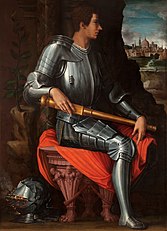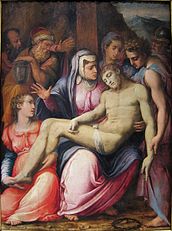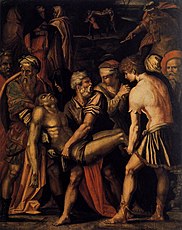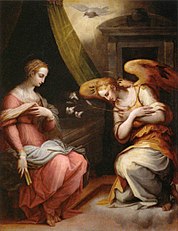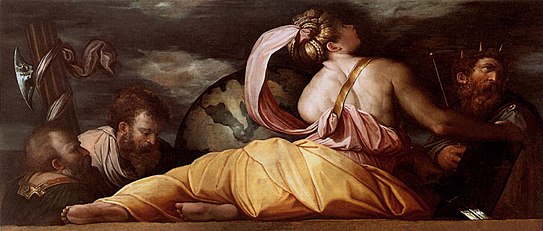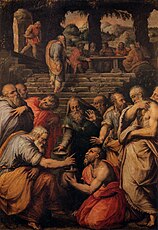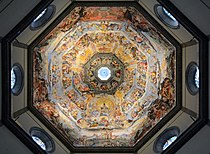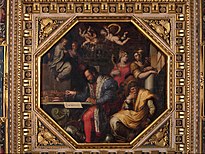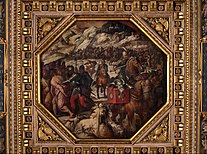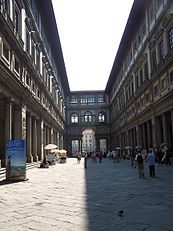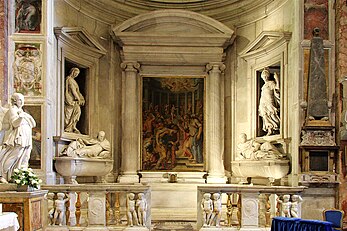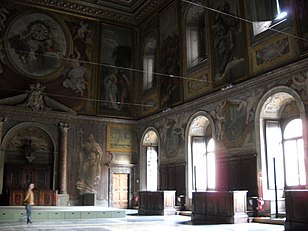Giorgio Vasari
Giorgio Vasari | |
|---|---|
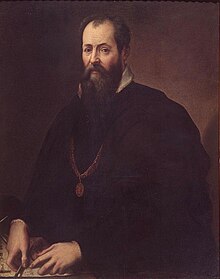 Self-portrait (c. 1571–74), Uffizi Gallery | |
| Born | 30 July 1511 |
| Died | 27 June 1574 (aged 62) |
| Education | Andrea del Sarto |
| Known for |
|
| Notable work | The Lives of the Most Excellent Painters, Sculptors, and Architects |
| Movement | Renaissance |
| Spouse | Niccolosa Bacci |
Giorgio Vasari (/vəˈsɑːri/, US also /-ˈzɑːr-, vɑːˈzɑːri/;[1][2][3][4] Italian: [ˈdʒordʒo vaˈzaːri]; 30 July 1511 – 27 June 1574) was an Italian Renaissance painter, architect, art historian, and biographer who is best known for his work Lives of the Most Excellent Painters, Sculptors, and Architects, considered the ideological foundation of Western art-historical writing, and still much cited in modern biographies of the many Italian Renaissance artists he covers, including Leonardo da Vinci and Michelangelo, although he is now regarded as including many factual errors, especially when covering artists from before he was born.
Vasari was a Mannerist painter who was highly regarded both as a painter and architect in his day but rather less so in later centuries. He was effectively what would now be called the minister of culture to the Medici court in Florence, and the Lives promoted, with enduring success, the idea of Florentine superiority in the visual arts.
Vasari designed the Tomb of Michelangelo, his hero, in the Basilica of Santa Croce, Florence, that was completed in 1578. Based on Vasari's text in print about Giotto's new manner of painting as a rinascita (rebirth), author Jules Michelet, in his Histoire de France (1835),[5] suggested the adoption of Vasari's concept, using the term Renaissance (from French) to distinguish the cultural change. The term was adopted thereafter in historiography and is still in use today.
Life
[edit]Vasari was born prematurely on 30 July 1511 in Arezzo, Tuscany.[6] Recommended at an early age by his cousin Luca Signorelli, he became a pupil of Guglielmo da Marsiglia, a skillful painter of stained glass.[7][8] Sent to Florence at the age of sixteen by Cardinal Silvio Passerini, he joined the circle of Andrea del Sarto and his pupils, Rosso Fiorentino and Jacopo Pontormo, where his humanist education was encouraged. He was befriended by Michelangelo, whose painting style would influence his own. Vasari enjoyed high repute during his lifetime and amassed a considerable fortune. He married Niccolosa Bacci, a member of one of the richest and most prominent families of Arezzo. He was made Knight of the Golden Spur by the Pope. He was elected to the municipal council of his native town and finally, rose to the supreme office of gonfaloniere.[8]
Vasari built a fine house in Arezzo in 1547 and decorated its walls and vaults with paintings. It is now a museum in his honour named the Casa Vasari, whilst his residence in Florence is also preserved.[citation needed] In 1563, he helped found the Florentine Accademia e Compagnia delle Arti del Disegno, with Grand Duke Cosimo I de' Medici and Michelangelo as capi of the institution. Thirty-six artists were chosen as members.[9] He died on 27 June 1574 in Florence, Grand Duchy of Tuscany, aged 62.[6]
Painting
[edit]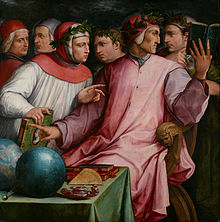
In 1529, he visited Rome where he studied the works of Raphael and other artists of the Roman High Renaissance. Vasari's own Mannerist paintings were more admired in his lifetime than afterwards. In 1547, he completed the hall of the chancery in Palazzo della Cancelleria in Rome with frescoes that received the name Sala dei Cento Giorni. He was regularly employed by members of the Medici family in Florence and Rome. He also worked in Naples (for example on the Vasari Sacristy), Arezzo, and other places. Many of his paintings still exist, the most important being on the wall and ceiling of the Sala di Cosimo I in the Palazzo Vecchio in Florence,[8] where he and his assistants worked from 1555. Vasari also helped to organize the decoration of the Studiolo, now reassembled in the Palazzo Vecchio.

In Rome, Vasari painted frescos in the Sala Regia. Among his better-known pupils or followers are Sebastiano Flori, Bartolomeo Carducci, Mirabello Cavalori (Salincorno), Stefano Veltroni (of Monte San Savino), and Alessandro Fortori (of Arezzo).[11] His last major commission was a vast The Last Judgement fresco on the ceiling of the cupola of the Florence Cathedral that he began in 1572 with the assistance of the Bolognese painter Lorenzo Sabatini. Unfinished at the time of Vasari's death, it was completed by Federico Zuccari.
Architecture
[edit]
Aside from his career as a painter, Vasari was successful as an architect.[12] His loggia of the Palazzo degli Uffizi by the Arno opens up the vista at the far end of its long narrow courtyard. It is a unique piece of urban planning that functions as a public piazza, and which, if considered as a short street, is unique as a Renaissance street with a unified architectural treatment.[clarification needed] The view of the Loggia from the Arno reveals that, with the Vasari Corridor, it is one of the very few structures lining the river that is open to the river and appears to embrace the riverside environment.[13]
In Florence, Vasari also designed the long passage, now called Vasari Corridor, which connects the Uffizi with the Palazzo Pitti on the other side of the river. The corridor passes alongside the River Arno on an arcade, crosses the Ponte Vecchio, and winds around the exterior of several buildings. It was once the location of the Mercado de Vecchio.[14] He renovated the medieval churches of Santa Maria Novella and Santa Croce. In both buildings, he removed the original rood screen and loft, and remodeled the retro-choirs in the Mannerist taste of his time.[8]
In Santa Croce, Vasari produced the painting of The Adoration of the Magi commissioned by Pope Pius V in 1566 and completed in February 1567. It was restored recently, before being exhibited in 2011 in Rome and Naples. Eventually, it will be returned to the church of Santa Croce in Bosco Marengo (Province of Alessandria, Piedmont).[citation needed] In 1562, Vasari built the octagonal dome on the Basilica of Our Lady of Humility in Pistoia, an important example of High Renaissance architecture.[15] In Rome, Vasari worked with Giacomo Barozzi da Vignola and Bartolomeo Ammannati at Pope Julius III's Villa Giulia.
The Lives of the Most Excellent Painters, Sculptors, and Architects
[edit]Often called "the first art historian",[16] Vasari invented the genre of the encyclopedia of artistic biographies with his Le Vite de' più eccellenti pittori, scultori, ed architettori (Lives of the Most Excellent Painters, Sculptors, and Architects). This work was first published in 1550 and dedicated to Grand Duke Cosimo I de' Medici. Vasari introduced the term "Rinascita" (rebirth in Italian) in printed works – although an awareness of an ongoing "rebirth" in the arts had been in the air since the time of Alberti. Vasari's term, applied to the change in artistic styles with the work of Giotto, eventually would become the French term Renaissance (rebirth) widely applied to the era that followed. Vasari was responsible for the modern use of the term Gothic art, as well, although he only used the word Goth in association with the German style that preceded the rebirth, which he identified as "barbaric". The Lives also included a novel treatise on the technical methods employed in the arts.[8][17] The book was partly rewritten and extended in 1568,[8] with the addition of woodcut portraits of artists (some conjectural).[citation needed]

The work shows a consistent and notorious bias in favour of Florentines and tends to attribute to them all the developments in Renaissance art – for example, the invention of engraving. Venetian art in particular (along with arts from other parts of Europe), is ignored systematically in the first edition. Between his first and second editions, Vasari visited Venice and while the second edition gave more attention to Venetian art (finally including Titian), it did so without achieving a neutral point of view.[citation needed]
Many inaccuracies exist within his Lives. For example, Vasari writes that Andrea del Castagno killed Domenico Veneziano, which is incorrect; Andrea died several years before Domenico. In another example, Vasari's biography of Giovanni Antonio Bazzi, whom he calls "Il Sodoma", published only in the second edition of the Lives (1568) after Bazzi's death, condemns the artist as being immoral, bestial, and vain. Vasari dismisses Bazzi's work as lazy and offensive, despite the artist's having been named a Cavalier of the Supreme Order of Christ by Pope Leo X and having received important commissions for the Villa Farnese and other sites.[18]
Vasari's biographies are interspersed with amusing gossip. Many of his anecdotes seem plausible, while others are assumed fictions, such as the tale of young Giotto painting a fly on the surface of a painting by Cimabue that supposedly, the older master repeatedly tried to brush away (a genre tale that echoes anecdotes told of the Greek painter Apelles). He did carry out research archives for exact dates, as modern art historians do, and his biographies are considered more reliable in the case of his contemporary painters and those of the preceding generation. Modern criticism – with new materials produced by research – has revised many of his dates and facts.[8] Vasari included a short autobiography at the end of the Lives, and added further details about himself and his family in his lives of Lazzaro Vasari and Francesco Salviati.[8]
According to the historian Richard Goldthwaite,[19] Vasari was one of the earliest authors to use the term "competition" (or "concorrenza" in Italian) in its economic sense. He used it repeatedly, and stressed the concept in his introduction to the life of Pietro Perugino, in explaining the reasons for Florentine artistic preeminence. In Vasari's view, Florentine artists excelled because they were hungry, and they were hungry because their fierce competition amongst themselves for commissions kept them so. Competition, he said, is "one of the nourishments that maintain them".[citation needed]
Gallery
[edit]- Paintings by Giorgio Vasari
-
Alessandro de Medici resting
-
Pieta
-
Bird catchers
-
Holy Family, with Andrea del Sarto
-
Last Supper
-
Entombment
-
Temptations of St. Jerome
-
St. Luke painting the Virgin
-
Annunciation
-
Justice
-
The Prophet Elisha
- Frescos and decorations by Giorgio Vasari
-
Interior of the dome of Florence Cathedral
-
Cosimo studies the taking of Siena.
-
Apotheosis of
Cosimo I -
Defeat of the Venetians in Casentino
- Libro de' Disegni by Giorgio Vasari
-
Giorgio Vasari with drawings by Filippino Lippi, Botticelli, and Raffaellino del Garbo
- Architecture by Giorgio Vasari
-
Uffizi colonnade and loggia
-
Loggia of Vasari in Arezzo
-
San Pietro in Montorio, Rome
-
Tomb of Michelangelo
-
Sala dei Cento Giorni - Giorgio Vasari - 1547 - Palazzo della Cancelleria
-
Villa Giulia - Court - Vasari - Vignola
-
Part of the Loggia del Mercato Vecchio, Florence, just prior to its demolition in the 1880s
References and sources
[edit]References
- ^ "Vasari". Collins English Dictionary. HarperCollins. Retrieved 1 June 2019.
- ^ "Vasari, Giorgio" (US) and "Vasari, Giorgio". Oxford Dictionaries UK English Dictionary. Oxford University Press. Archived from the original on 9 November 2021.
- ^ "Vasari". The American Heritage Dictionary of the English Language (5th ed.). HarperCollins. Retrieved 1 June 2019.
- ^ "Vasari". Merriam-Webster.com Dictionary. Merriam-Webster. Retrieved 1 June 2019.
- ^ Michelet, Jules (1835). Histoire de France: Renaissance. Vol. VII. Paris.
- ^ a b Gaunt, W. (ed.) (1962) Everyman's dictionary of pictorial art. Volume II. London: Dent, p. 328. ISBN 0-460-03006-X
- ^ "Art in Tuscany | Giorgio Vasari and Italian Renaissance painting | Podere Santa Pia, Holiday house in the south of Tuscany". www.travelingintuscany.com. Retrieved 1 October 2017.
- ^ a b c d e f g h One or more of the preceding sentences incorporates text from a publication now in the public domain: Chisholm, Hugh, ed. (1911). "Vasari, Giorgio". Encyclopædia Britannica. Vol. 27 (11th ed.). Cambridge University Press.
- ^ Gauvin Alexander Bailey, 'Santi di Tito and the Florentine Academy: Solomon Building the Temple in the Capitolo of the Accademia del Disegno (1570–71)', Apollo CLV, 480 (February 2002): pp. 31–39.
- ^ "Six Tuscan Poets, Giorgio Vasari". Minneapolis Institute of Art.
- ^ The History of Painting in Italy: The Florentine, Sienese, and Roman schools, by Luigi Lanzi, page 201-202.
- ^ "Vasari's ability as a painter cannot match his talents either as a historian or as an architect," according to Lawrence Gowing, ed., Biographical Encyclopedia of Artists, v.4 (Facts on File, 2005): 695.
- ^ "Tuscan artists' insight: Giorgio Vasari". FlorenceItaly. 21 February 2014. Retrieved 16 September 2024.
- ^ Pevsner, N., A History of Building Types, Princeton University Press, 1979, pg. 235
- ^ The Christian Travelers Guide to Italy by David Bershad, Carolina Mangone, Irving Hexham 2001 ISBN 0-310-22573-6-page [1]
- ^ Vasari, Giorgio Archived 6 November 2018 at the Wayback Machine Dictionary of Art Historians, 2013. Retrieved 26 May 2013.
- ^ Vasari, Giorgio. (1907) Vasari on technique: being the introduction to the three arts of design, architecture, sculpture, and painting, prefixed to the Lives of the most excellent painters, sculptors, and architects. G. Baldwin Brown Ed. Louisa S. Maclehose Trans. London: Dent.
- ^ Zarucchi, Jeanne Morgan (2015). "Vasari's Biography of Bazzi as 'Soddoma:' Art History and Literary Analysis". Italian Studies. 70 (2): 167–190. doi:10.1179/0075163415Z.00000000094. S2CID 191976882.
- ^ Richard Goldthwaite, The Economy of Renaissance Florence, 2009, pg. 390.
Sources
- The Lives of the Artists. Oxford University Press, 1998. ISBN 0-19-283410-X
- Lives of the Painters, Sculptors and Architects, Volumes I and II. Everyman's Library, 1996. ISBN 0-679-45101-3
- Vasari on Technique. Dover Publications, 1980. ISBN 0-486-20717-X
- Life of Michelangelo. Alba House, 2003. ISBN 0-8189-0935-8
- Herbermann, Charles, ed. (1912). . Catholic Encyclopedia. Vol. 15. New York: Robert Appleton Company.
Further reading
[edit]- Barriault, Anne B.; Ladis, Andrew T.; Land, Norman E.; Wood, Jeryldene M., eds. (2005). Reading Vasari. London: Philip Wilson.
- Guagliumi, Silvia.Giuliano da San Gallo architettore, Tau editrice, Todi 2016
- Guagliumi, Silvia.Raffaello da pittore ad architettore.Milano Giugno/Luglio 2023 ISBN 979-12-210-4000-5.
- Guagliumi, Silvia.Antonio da San Gallo il Vecchio, Milano Giugno 2024 ISBN 979-12-210-6439-1.
- Cast, David J., ed. (2013). The Ashgate Research Companion to Giorgio Vasari. Abingdon-on-Thames, Oxfordshire, England: Routledge. doi:10.4324/9781315613017. ISBN 9781409408475.
External links
[edit]- Agosti, Barbara (2020). "VASARI, Giorgio". Dizionario Biografico degli Italiani, Volume 98: Valeriani–Verra (in Italian). Rome: Istituto dell'Enciclopedia Italiana. ISBN 978-8-81200032-6.
- Works by Giorgio Vasari at Project Gutenberg
- Works by or about Giorgio Vasari at the Internet Archive
- Works by Giorgio Vasari at LibriVox (public domain audiobooks)

- Works by Giorgio Vasari at Open Library
- Biography of Vasari and analysis for four major works
- Petri Liukkonen. "Giorgio Vasari". Books and Writers.
- Giorgio Vasari – The First Art-Historian
Copies of Vasari's Lives of the Artists online:
- “Giorgio Vasari's Lives of the Artists.” Site created by Adrienne DeAngelis. Now largely completed in the posting of the Lives, intended to be re-translated to become the unabridged English version.
- Le Vite, 1550 Unabridged, original Italian.
- Stories Of The Italian Artists From Vasari, translated by E L Seeley, 1908. Abridged, in English.
- Le Vite – Edizioni Giuntina e Torrentiniana
- Gli artisti principali citati dal Vasari nelle Vite (elenco) Archived 13 December 2020 at the Wayback Machine
- Excerpts from the Vite combined with photos of works mentioned by Vasari.
- Giorgio Vasari
- Italian Mannerist painters
- Italian Mannerist architects
- 1511 births
- 1574 deaths
- Artist authors
- Italian biographers
- Italian art historians
- Italian art critics
- Italian male non-fiction writers
- Italian Roman Catholics
- Male biographers
- Painters from Tuscany
- People from Arezzo
- Art technological sources
- Uffizi
- 16th-century Italian architects
- 16th-century Italian painters
- Italian male painters
- 16th-century Italian writers
- 16th-century Italian male writers
- Biographers of artists
- Architects of Roman Catholic churches
- Catholic painters
- 16th-century biographers
- 16th-century Italian historians

